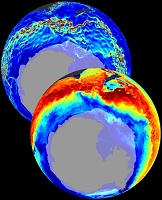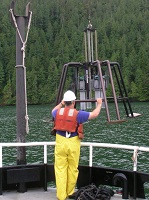Chemical Oceanography
Biogeochemical processes regulating the transformation of carbon in the oceans using both modeling and experimental approaches (Ito, Perdue, Taillefert).
Research in this area includes understanding and predicting the processes that regulate the transformation of carbon in both water column and sediments. The overall objective is to understand how much carbon can be absorbed and preserved under the form of organic matter in the oceans.

To realize this objective, the composition of natural organic matter (NOM) in the water column of the oceans is characterized using state-of-the-art NMR and mass spectrometry techniques. As its concentration is low in seawater, researchers in EAS have developed a new technique to isolate and preconcentrate NOM from seawater (Perdue, Ingall).
In parallel, the preservation of NOM in sediments is investigated by studying the processes that regulate its transformation. The overall objective of this research is to quantify the rate of carbon remineralization in sediments to understand how the sediment will react to the increase in the flux of NOM from the new input in CO2 to the surface waters. As direct carbon measurements cannot be realized easily, researchers in EAS are developing new in situ instrumentation to the inorganic electron acceptors involved in the transformation of NOM or the inorganic by-products of its transformation (Taillefert).
Finally, numerical models are used to study the cycling of carbon in the global oceans. General circulation models (GCM) are coupled with a biogeochemistry and ecosystem components to simulate the climate change impacts on marine ecosystem, ocean productivity and the sequestration of atmospheric CO2 into the deep ocean. The link between climate variability and the global biogeochemical cycles is poorly understood, and the evolution of the Earth's climate depends on the strength of oceanic carbon sink. Feedbacks between climate and biogeochemistry are investigated using theoretical and computational approaches (Ito).
Characterizing the cycling of nutrients in the oceans (Ingall, Ito, Kostka)
Nitrogen and phosphorus are essential elements to life on Earth, and research is conducted in EAS to study their transformation in the oceans and their effect on the carbon cycle. With regard to the nitrogen cycle, most reactions are catalyzed by microorganisms. Thus, EAS researchers seek to determine the rates, pathways, and microbial groups responsible for the transformation of fixed nitrogen or biologically available nitrogen (i.e., NH4+, NO2-, NO3-). As fixed nitrogen often limits production in the world’s oceans, investigations specifically target the microbial processes (denitrification, anammox) responsible for the removal of fixed nitrogen from ecosystems (Kostka).

With regard to the phosphorus cycle, researchers are investigating the role of organic phosphorus compounds that are found ubiquitously in the water column of the oceans (Ingall). Newly developed electrodialysis-reverse osmosis techniques have allowed researchers to isolate and preconcentrate marine dissolved organic phosphorus (DOP) which is characterized using NMR and various wet chemical techniques. Simultaneously, the accumulation and storage of phosphorus in marine phytoplankton is studied using synchrotron-based x-ray spectromicroscopic techniques.
Finally, iron is a micronutrient that limits primary production in some regions of the oceans, the High Nutrient Low Chlorophyll (HNLC) zones. Research in EAS is focused on predicting the effect of iron limitation on the carbon cycle (Ito). Questions tackle by these projects include defining how atmospheric circulation affects iron inputs and primary production in the upper ocean and how the sediment may provide a significant source of iron to sustain primary production in surface waters.
Paleoclimate and Paleoceanography (Cobb, Lynch-Stieglitz)

Paleoclimate data are becoming increasingly important in climate science, as more accurate regional projections of future climate change require knowledge of climate variability over the recent past. Paleoclimate research at Georgia Tech focuses on i) resolving the history of El Nino-Southern Oscillation variability over the last several millennia as recorded in coral and cave archives (Cobb), ii) resolving the oceanographic and atmospheric signatures of abrupt climate change in both the Atlantic and Pacific oceans using cave and sedimentary archives (Cobb, Lynch-Stieglitz), iii) reconstruction of past ocean circulation and its relationship to climate (Lynch-Stieglitz), iv) reconstructing and understanding how the mean state of the tropical ocean/climate system varied over glacial cycles (Lynch-Stieglitz), and v) investigating the modern-day climatic interpretation of geochemical climate proxies through on-site calibration studies (Cobb).
Facilities include two stable isotope mass spectrometers for analysis of carbonates, a JY-Horiba ICP for trace metal analyses, and a Picarro water isotope analyzer. On-going collaborations with EAS colleagues allows access to large computer clusters where paleo-simulations of GCMs are performed to complement students’ paleoclimate reconstructions, where appropriate.